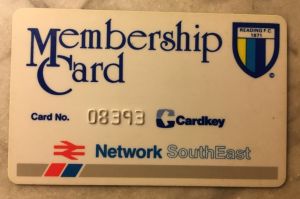
Looking back, football in the 1980s was largely incidental to what else was going on in my life. This was quite normal, not just for me, but for pretty much all my friends and acquaintances. We would go to football only if we didn’t get a better offer. Not for me the all-day 10-pint binge of a Saturday that seems to be de facto these days (to be fair I have never been able drink 10 pints). It was far more a last-minute decision to go, park in Tilehurst Road at 2:50, into the South Bank by 2:59, see who else was there, and home again by 5:30. No need for season tickets in those days, cash on the door.
And yet the drama the decade produced for our club was unprecedented. All Maurice Evans’ good work undone by 1983 under the spectre of Maxwell’s “merger”; Branfoot’s record-breaking start in 1985; a first promotion to the second tier in 60 years; an actual cup win at Wembley; the inevitable relegation back to square one to end the decade.
Still, in football terms, the 1980s are generally remembered for the negatives. A fan’s death at Birmingham in a riot on the same day as the Bradford City fire. For the all-conquering Liverpool team, think Heysel and, inevitably, Hillsborough, at that time assumed to have been caused by hooliganism. Football had to change, or eventually die. And that change, it turned out, was to be imposed, not by the police or football authorities, but by the government itself.
Fans would have to register with their clubs and become members. To get into a game, home or away, the fan would need to produce their membership card. Apart from the glaring limitations of the system (no photographic identification required), the response from clubs and fans alike was one of astonishment and outrage. Forward-thinking Reading however, apparently representing Europe’s self-styled “Silicon Valley”, were keen, early adopters of the proposed identity card scheme. We all had to register to get a card, which, after paying, you would present to a card reader to unlock the turnstile. Many of us were actually perfectly comfortable using it, having exactly this kind of system in our workplaces, often supplied by Reading-based Cardkey Systems in Tilehurst. Nevertheless, the national scheme was dead before it ever got off the ground, with Reading possibly the only club to actually implement it. A few months into it, the club simply switched it off.
When I look at my card now, it transports me back to those great days of the 1980s, not just football at Elm Park but my whole life as a young, single man. I think of games under the floodlights in the pouring rain, the players we loved (and hated), the drama of games like the Plymouth comeback or beating Chelsea in the League Cup, the 13 wins in a row. But I also remember things like the hooliganism and the embarrassment I could sometimes feel when admitting to being a football fan in more “enlightened” company. And ultimately, I think about how, back then, unlike today, football didn’t really matter that much. All this from just one little piece of faded plastic.
This piece of memorabilia is from Terry Smith

